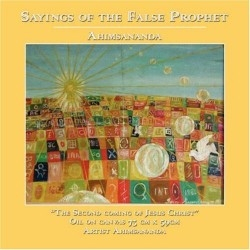Sayings of the False Prophet
“What is the sound of one hand clapping?” Here is a seeker who deals in spiritual questions and satisfying answers. Scottish poet and painter Ahimsananda uses axioms, koans, and prose poems to stimulate healthier mindsets. The overriding aim is to shake spiritual and mental complacency from those who are “dead from the neck up.” Ahimsananda is out to reconcile segments of society currently divided by false arguments, as in “The Creation of Man”: “If one adjusts one’s perspective of the element of time, evolution and creation are one and the same and the schism disappears.”
The author’s forty-year examination of Christian and Buddhist faiths conducted while he resided in both Europe and North America has yielded a set of beliefs which meld compatible elements. The importance of mindfulness in one’s conduct with other people is underlined and a belief in reincarnation coexists with a direct experience of divine goodness apparently drawn from the Gospel of Thomas and similar sources. The author’s conclusions are akin to those of the Vietnamese monk Thich Nhat Hanh, who raised awareness of the harmonious overlap between doctrines with Living Buddha, Living Christ.
Subjects of the book’s eight oil paintings run from conceptual—the cover piece, “The Second Coming of Jesus Christ,” is composed of light rays above multicolored quilt squares adorned with short words and symbols—to impressionistic, as in “Balena,” which features an anchored ship topped by a Calvary-like assemblage of crosses which double as masts. One unexpected subject is sports cars, the existence of which the author puts forth as a concrete sign that miracles do happen.
However, these largely affirmative writings represent a message which is perhaps more piecemeal than unitary. Ahimsananda advocates the wearing of sandals based on a verse from the Gospel according to Mark; he doesn’t lay out the beneficial effects of doing so, beyond mentioning that simple footwear promotes humility. A handful of unusual ideas beg further explanation. For example, in “Observations” he asks: “Do you feel anger or fear? When you can no longer tell the difference you have reached reverence.”
Sayings of the False Prophet gently encourages people to begin their owns quests for higher consciousness. It suggests that right perception is the first necessary step in bettering conditions in this life and after. On the lighter side, it cuts cleanly through the ever-perplexing chicken/egg conundrum. And the answer to the most famous Zen riddle? “It depends what it is clapping against.”
Disclosure: This article is not an endorsement, but a review. The publisher of this book provided free copies of the book and paid a small fee to have their book reviewed by a professional reviewer. Foreword Reviews and Clarion Reviews make no guarantee that the publisher will receive a positive review. Foreword Magazine, Inc. is disclosing this in accordance with the Federal Trade Commission’s 16 CFR, Part 255.

